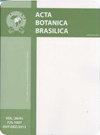Discovery of Backusella paraconstricta sp. nov. (Mucorales, Mucoromycota) in an upland forest in northeastern Brazil with an identification key for Backusella from the Americas
IF 1.1
4区 生物学
Q4 PLANT SCIENCES
引用次数: 0
Abstract
During a survey of mucoralean fungi in soil from an upland forest area located in Pernambuco, Brazil, a strain of Backusella (URM 8637) was isolated. Based on morphological, physiological, and molecular data [internal transcribed spacer (ITS) and large subunit (LSU) ribosomal DNA regions], it was recognized that this Backusella differed from all other species in the genus. Morphologically, the new species is characterized as forming varied-shaped columellae, including elongated, basally constricted, unisporate (rare) and multisporate sporangiola, and ellipsoidal sporangiospores. The maximum temperature growth of URM 8637 on malt extract agar and potato dextrose agar was 36 °C. In the phylogram, it was closely related to B. constricta. Based on the evidence from the analyzed datasets, a new species of Backusella is proposed. An updated identification key for Backusella from the Americas is provided.在巴西东北部的高地森林中发现了背孢菌(Mucorales, Mucoromycota),并获得了美洲背孢菌的鉴定钥匙
在对巴西伯南布哥一高地林区土壤中mucoralean真菌的调查中,分离到一株Backusella (URM 8637)。基于形态学、生理学和分子数据[内部转录间隔区(ITS)和大亚基(LSU)核糖体DNA区域],人们认识到该Backusella与属中所有其他物种不同。形态学上,新种的特点是形成多种形状的小孢子,包括细长的,基部收缩的,单孢子(罕见)和多孢子的孢子囊,椭圆形的孢子囊孢子。URM 8637在麦芽膏琼脂和马铃薯葡萄糖琼脂上的最高生长温度为36℃。在系统分布图上,与缢蛏亲缘关系较近。根据所分析的资料,提出了一种新的Backusella属。提供了来自美洲的Backusella的最新识别密钥。
本文章由计算机程序翻译,如有差异,请以英文原文为准。
求助全文
约1分钟内获得全文
求助全文
来源期刊

Acta Botanica Brasilica
PLANT SCIENCES-
CiteScore
2.30
自引率
9.10%
发文量
32
审稿时长
6-12 weeks
期刊介绍:
Experimental, theoretical and applied papers on all aspects of plant (including algae) and fungi biology are welcome. The submitted manuscript or its essential content must not have been published previously or be under consideration for publication elsewhere. Contributions should be substantial, written in high-quality English and show general interest. We expect that the submitted manuscript presents a great novelty in Botany, and this should attract a wide audience. Considering this, case studies are only considered if the narrative and implications are provided to be of general interest. Thus, manuscripts that report aspects of local interest are discouraged unless the implications of the findings are wide-reaching. Manuscripts with agronomic subjects are expected to contain a substantial amount of basic plant biology. Please see below some details for specific area.
 求助内容:
求助内容: 应助结果提醒方式:
应助结果提醒方式:


